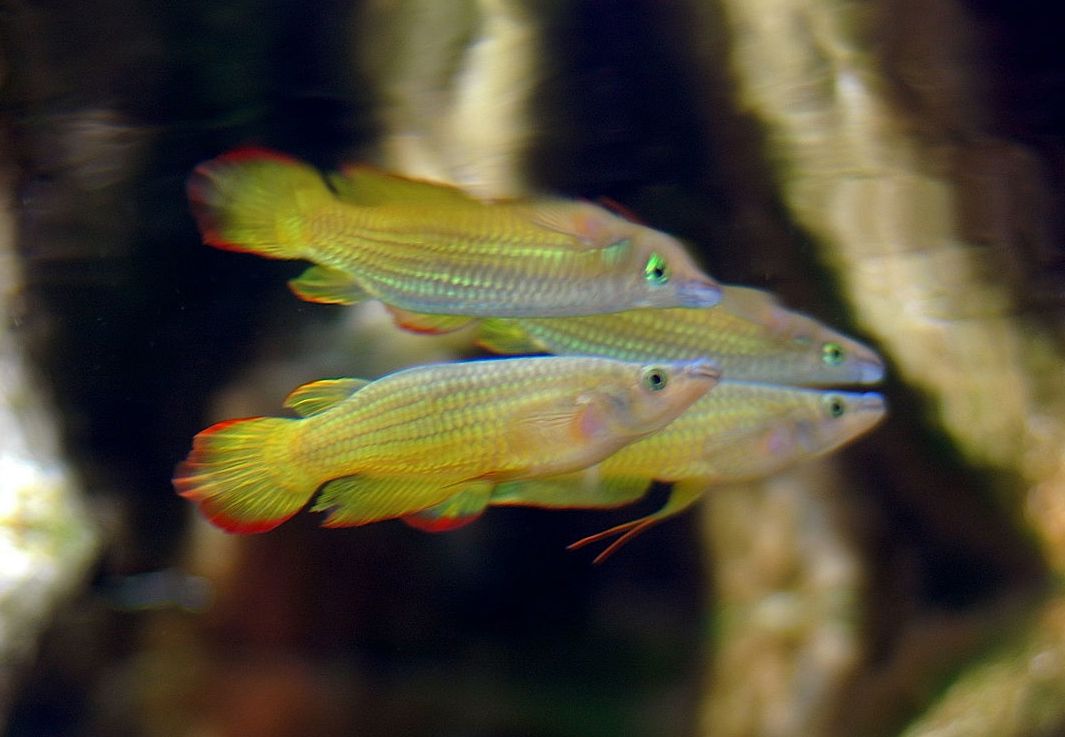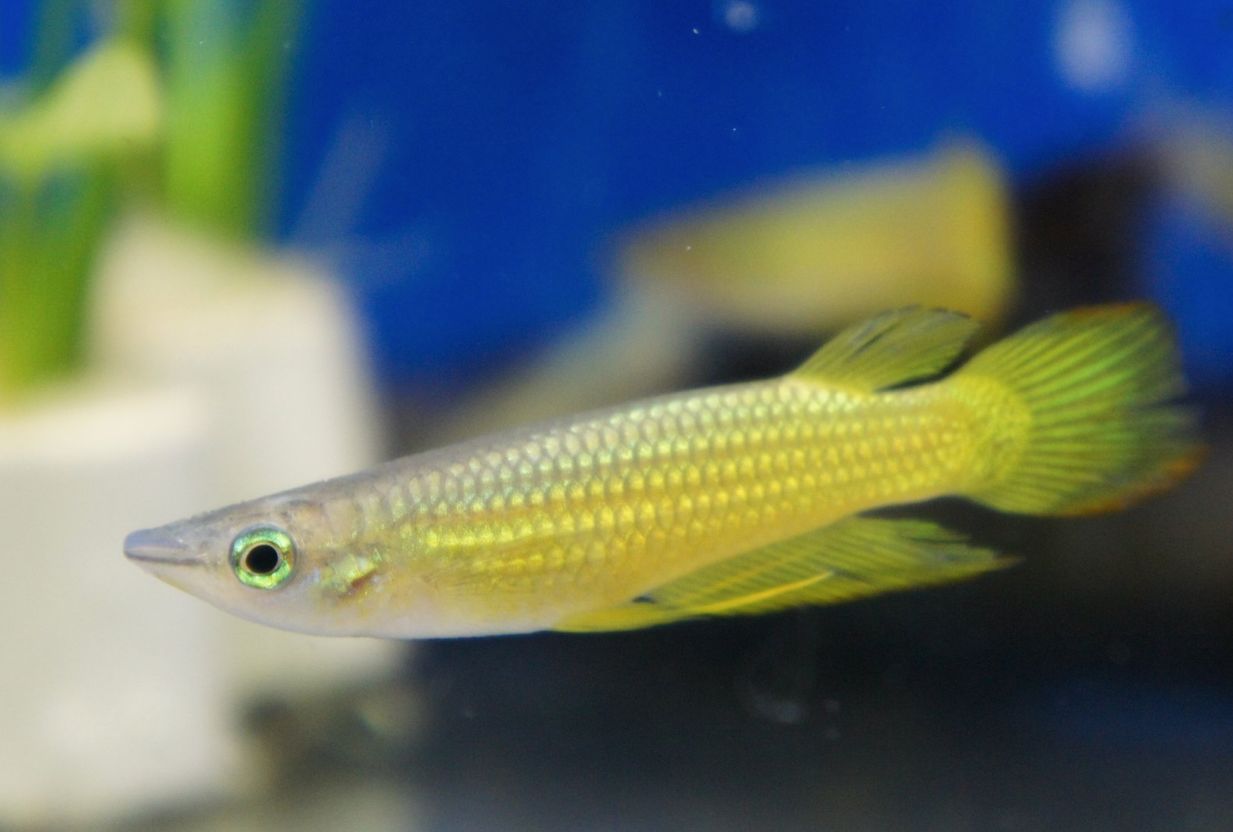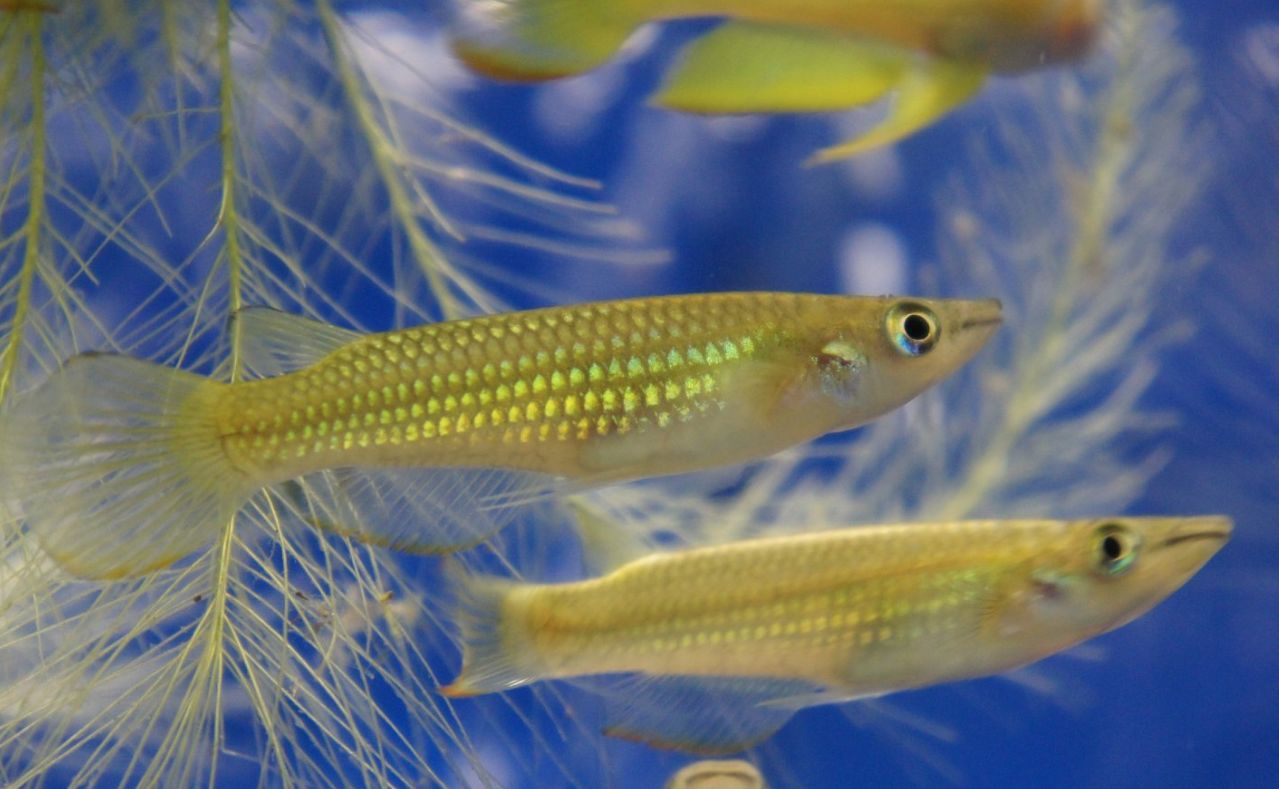The striped panchax (Aplocheilus lineatus) is a tropical freshwater aquarium fish that belongs to the genus Aplocheilus. Wild striped panchax killifish has a rather unpretentious coloring – bronze-colored body, reddish fins, and some dark vertical stripes near its tail. However, due to breeders’ efforts, a golden-colored variation of the fish was obtained – golden striped panchax. It is considered the most popular nowadays.

Contents
Habitat in the wild
The striped panchax, also known as Aplocheilus lineatus, is a species of freshwater fish belonging to the family Aplocheilidae. The Aplocheilidae family is a group of small tropical and subtropical fish commonly referred to as “killifishes.”
Killifishes are known for their vibrant colors, diverse patterns, and unique breeding behaviors. They are popular among aquarium enthusiasts due to their beauty and relatively small size. The striped panchax is native to parts of South Asia and is commonly found in slow-moving or stagnant freshwater bodies like ponds, swamps, and ditches. In the aquarium hobby, they are appreciated for their striking appearance and interesting behaviors.
The killifish habitat includes the territory of East India, and it was introduced in Sri Lanka, where they use it to control the mosquitoes population. Locals use the fish to fight mosquitoes by putting it in small freshwater ponds near their houses. Natural biotopes of this fish are slowly flowing waters, bogs, flooded lowlands, irrigation channels. It dwells in waters with a temperature of about 22 – 25 °C.
The striped panchax appeared in home aquariums more than 100 years ago (in 1909), in Germany, where it was first successfully bred. This kind demonstrated itself to be an enduring tank fish, capable of adapting quickly to various tank conditions. Moreover, striped panchax is easy to breed.
Description
Size
The striped panchax (Aplocheilus lineatus) typically grows to a size of up to approximately 3 inches (7.5 centimeters) in length. This size makes them relatively small, which is one of the reasons they are popular among aquarium enthusiasts, as they can be comfortably housed in smaller tanks compared to larger fish species. As with most fish, individual sizes can vary slightly, but a mature striped panchax will generally fall within this size range.
Lifespan
The average lifespan of the striped pPanchax is around 2 to 3 years in captivity. However, it’s essential to note that this lifespan can vary depending on various factors, including the quality of care provided, the aquarium environment, and the genetic health of the fish.
Coloring
It has gray with a greenish tint body which is darker on top with black vertical stripes on it (from 4 to 6), and this is how the fish name originated — «lineatus».
The fins have the same color as the body but are a bit paler. Anal and tail fins have black edges of different color intensities. Abdominal fins are elongated, and several of their rays transform into thin filaments.
Provided with lateral illumination, the striped panchax looks really appealing. Scales of the adult males in the reflected light shines with bright green. For this reason, the source of light in a tank should be located closer to the viewing glass.
The tall and long anal fin, together with the dorsal and tail ones, makes a single powerful blade that enables the fish to push effectively to jump out of the water when hunting flying insects and also to change its direction under the water abruptly.
Currently, there are three color variations of striped panchax killifish known: natural, golden, and red one.
In 1993, among the fish brought to Europe from Goa province together with naturally colored species, some golden-colored species were found. The new color variation attracted the aquarists’ attention right away.
If compared to natural golden striped panchax coloring, these species were brighter, which was a rare thing among tank fishes. Their main body color was golden-yellow with unpaired fins of the same color. The very first fish spawning showed that this attribute is inheritable. This is how the golden variation appeared in home aquariums.
In the case of the red color variation of the fish, the male body has greenish and olive-brown colors with a reddish tint. On the sides, it has small golden-green shiny scattered spots that are red on its chest. Each scale has a large red spot, due to which there is an impression that the fish body is sparkling.
Tank conditions for the successful keeping of gold and red color variations of the fish are the same as its natural form requirements.
| Characteristic | Description |
|---|---|
| Scientific Name | Aplocheilus lineatus |
| Common Name | Striped Panchax; panchax fish; striped panchax killifish; yellow panchax; golden wonder killifish |
| Family | Aplocheilidae |
| Habitat | Slow-moving or stagnant freshwater bodies |
| Native Range | South Asia (India, Sri Lanka, Bangladesh) |
| Size | Up to approximately 3 inches (7.5 centimeters) in length |
| Lifespan | Around 2-3 years in captivity |
| Behavior | Peaceful and relatively shy; may jump out of the water |
| Diet | Carnivorous, primarily feeds on small insects and worms |
| Temperature Range | 72°F to 82°F (22°C to 28°C) |
| pH Range | 6.0 to 7.5 |
| Water Hardness | Soft to slightly hard water (4-15 dGH) |
| Tank Size | Minimum 10-gallon tank for a small group |
| Tank Level | Middle to top, prefers floating or surface vegetation |
| Compatibility | Peaceful community fish, avoid aggressive tankmates |
| Breeding | Egg-scattering species; lay eggs among plants or moss |
| Special Considerations | Provide hiding spots, densely planted tanks |

Difficulties in keeping
Bright coloring, rather peaceful temper, and active behavior in a tank make wonder killifish desired in house ponds. Easy breeding and keeping conditions let us recommend them even for beginners to keep.
Care and keeping in a tank
Tank size
It is better to keep striped panchax in small groups of 4 species at least.
The minimum recommended tank size for keeping striped pPanchax is a 10-gallon tank for a small group of fish. However, providing a larger tank is always better as it allows for more swimming space and provides a more stable environment.
In a 10-gallon tank, you could keep a small group of striped panchax (3 to 4 individuals) comfortably. Keep in mind that it’s essential to maintain good water quality, especially in smaller tanks, as they can be more susceptible to water parameter fluctuations.
If you plan to keep other fish along with the striped panchax in the same tank, you’ll need to consider the compatibility and the space requirements of the other species. Make sure to research the specific needs and behaviors of any additional fish you wish to include in the tank to ensure they can coexist peacefully.
For a more natural and less stressful environment for the fish, it’s a good idea to include plenty of plants and hiding spots in the tank. Live plants also help in maintaining water quality by absorbing excess nutrients and providing oxygen.
Remember that overcrowding can lead to stress, aggression, and water quality issues, so it’s crucial to provide enough space for the fish to thrive. If possible, choose the largest tank that fits your budget and available space to create a better environment for your striped panchax and any other fish you wish to keep.
Water parameters
Water parameters aren’t that important for the fish, and it can dwell both in soft and hard water, preferably neutral or slightly acidic. Optimal tank conditions are the following:
- Temperature: 72°F to 82°F (22°C to 28°C)
- pH Level: 6.0 to 7.5
- Water Hardness (dGH): Soft to slightly hard water, ideally between 4 to 15 degrees German hardness (dGH)
It’s important to keep the water temperature stable within the recommended range. Fluctuations in temperature can stress the fish and make them more susceptible to diseases. They feel quite good at a rather wide variety of temperatures, from 20 to 30 °C. However, 24°С can be considered optimal water temperature for them.
Maintaining the pH level within the suggested range is also essential. pH measures the acidity or alkalinity of the water. Striped Panchax prefer slightly acidic to neutral water conditions.
Water hardness refers to the concentration of dissolved minerals in the water. Striped panchax can adapt to a range of water hardness levels, but keeping it within the specified range will ensure they thrive in the aquarium.
Regular water testing is essential to monitor these parameters. If you find that the water conditions are not within the recommended range, take appropriate measures to adjust them slowly and gradually. Rapid changes in water parameters can be stressful and harmful to the fish.
It’s also important to conduct regular water changes to remove accumulated pollutants and maintain water quality. Aim for weekly or bi-weekly water changes, depending on the size of the tank and the number of fish.
By providing suitable water conditions and maintaining good water quality, you can create a healthy and thriving environment for your striped panchax.
Tank setup: decorations and plants
Striped panchax prefer staying under fluctuants. At this, the fish mouth is on the boundary of two mediums (water and air) and maximally close to potential prey, which is near the water surface.
When keeping it in a species tank or with calm tempered fishes of similar size, it often swims in the middle and sometimes bottom water layers. It likes spending time among thickly growing plants or gathering in a school under a large plant leave. In general, the fish isn’t timid, but in case of danger, they tend to hide in tank plants or under fluctuant. They turn in the direction of the threading object watching it.
In a tank, a dark-colored substrate is preferable. There should be some sickly planted areas with snags in them.
The tank lighting shouldn’t be too bright since striped panchax prefers dim light. To create such conditions, put some fluctuant on the water surface (for example, water lettuce) or use tank plants that grow their leaves to reach the water surface (Vallisneria).
Filtration
Filter and heater are a must in the tank. The filter will keep the water clean, while the heater will heat the water to a comfortable temperature for the fish.
Diet
Wild striped panchax is a predator that waits for its prey under plant leaves to catch it in one move once it gets close. In the wild, its diet mainly consists of flying insects, their larvae, fish juveniles, and small fishes that swim in upper water layers.
In a tank, they aren’t demanding as for the food. They eat standard types of live, frozen, and artificial food. Its amounts must be precisely calculated since the fish tends to overfeed. As for additives, these can be blood worms, flies, and other insects.
It’s essential to offer a varied diet to ensure your striped panchax gets all the necessary nutrients for optimal health and coloration. Feed them small amounts multiple times a day, as their small stomachs are better suited to frequent feeding rather than a single large meal. Avoid overfeeding, as it can lead to water quality issues and health problems.

Tank mates
Striped panchax is a predator, but it doesn’t mean you can’t keep it with other fishes. The most important thing you should consider when selecting its tank mates is that they shouldn’t be smaller than panchax killifish. Otherwise, sooner or later, they’ll become its prey.
For this reason, keeping it with cardinal tetra, celestial pearl danio, cherry barb, dwarf pencilfish, endler guppy, fancy guppy, and similar fishes is strictly not recommended. This fish treats its small-sized tank mates as potential prey, but they try to eat them only if very hungry. The rest of the time, it doesn’t pay much attention to them. However, considering its large mouth and ability to attack abruptly, the chance of a successful attempt to eat its tank mate is very high.
The way how striped panchax killifish chases small fishes has a lot of in common with how northern pike hunts: striped panchax freezes hiding under plants and waits for its prey to come as close as it can catch it in one move. When the potential prey becomes reachable, the fish curls its tail and then straightens it and attacks the prey.
You shouldn’t keep Aplocheilus lineatus with large cichlids (oscar fish, jaguar cichlid) that can easily swallow the young fish. Also, you should avoid any fan-tailed fish.
Large tank mates such as barbs (tiger barb, Odessa barb, denison barb, gold barb), large platy, swordtails, and mollies will be a good company for the fish. However, when putting very active fish together with striped panchax, ensure that the latter gets enough food.
Intraspecific conflicts are seldom the case, but you should keep the fish in groups with females prevailing there. Fights that occur between the males from time to time are more likely aimed to compete; thus, they won’t cause any serious injuries.
The fight between the males goes as follows: the rivals stay parallel to each other so that one fish’s head is against the other fish’s tail. Then they stretch their fins and stick out their gill covers, and their bodies start waving. The rival less successful during this exercise admits his defeat and leaves the duel place. The winner usually doesn’t haunt the defeated.
Gender differences: male vs. female
Females have less appealing coloring than males. The main color of their body is gray, with some sparkling golden-bronze scales on the sides. Females have shorter yellow-white fins. Their unpaired fins are more rounded with yellow-orange edges.
In the wild such coloring allows the fish to hide and makes them almost invisible among vertical stalks and water greenery. In case of a stressful situation, a rather wide dark stripe appears along the fish body. It is especially visible on the young species body.
Breeding
Breeding of all color morphs is not challenging. Provided with favorable conditions and bottom substrate, they often lay eggs in a community tank. To grow the juveniles, you should remove the substrate with eggs to the incubation tank.
You can use a spawning tank of about 20-30 liters capacity with a water level in it about 1-0-15 cm high. Water parameters required for breeding are the same as when keeping the fish. There should be some fluctuant on the water surface. Small-leaved plants are used as a spawning substrate, or a bunch of synthetic filaments will do as well. To stimulate the spawning process, add some soft water and raise its temperature.
The spawning occurs inside the thickly planted tank plants. Every day the female lays several eggs on them, and you should remove them to the incubator right away. A large female can lay up to 25 eggs a day. On average, you can get about 100 eggs in a week from one female.
The spawning continues for several weeks, then a break (10-14 days). The eggs are transparent, 1,4-1,6 mm in diameter.
Incubation time lasts for about two weeks. The breeders tend to eat their juveniles. The latter are quite large and can start to feed on brine shrimp nauplii from the very beginning.
Provided with a nutritious diet and regular water renew, the juveniles grow quickly. At the age of one month, they can be 1.5 cm long. Approximately at this age, it becomes possible to define the fish sex. The male fins become sharpened elongated, and get their coloring. Aplocheilus lineatus obtain their full coloring when they become reproductive and grow 6-7 cm long. This usually happens when they are 6 months old.